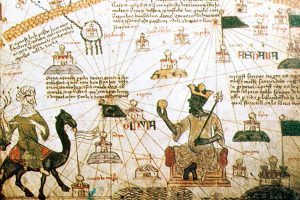Alex Colville in The Spectator:
 The main attraction in the Kenyan port of Mombasa is Fort Jesus, a vast, ochre-colored bastion overlooking the Indian Ocean. Dominating a dusty skyline of palm trees, minarets and tower blocks, it was erected during the opening cannonade of European empire. In 1505 a Portuguese armada sacked and torched Mombasa, shortly after its ‘discovery’ by Vasco da Gama. The fort stamped the city as theirs. The coming of the Portuguese is sometimes considered the beginning of African history — a story not about Africa itself, but about bemused Europeans exploring and taming a ‘dark’ continent. And if we look at Africa before 1505, we find a world as blank as one of da Gama’s maps. This has led many to believe, as G.W.F. Hegel did in the 1830s, that Africa ‘is no historical part of the world’.
The main attraction in the Kenyan port of Mombasa is Fort Jesus, a vast, ochre-colored bastion overlooking the Indian Ocean. Dominating a dusty skyline of palm trees, minarets and tower blocks, it was erected during the opening cannonade of European empire. In 1505 a Portuguese armada sacked and torched Mombasa, shortly after its ‘discovery’ by Vasco da Gama. The fort stamped the city as theirs. The coming of the Portuguese is sometimes considered the beginning of African history — a story not about Africa itself, but about bemused Europeans exploring and taming a ‘dark’ continent. And if we look at Africa before 1505, we find a world as blank as one of da Gama’s maps. This has led many to believe, as G.W.F. Hegel did in the 1830s, that Africa ‘is no historical part of the world’.
In The Golden Rhinoceros, the French historian François-Xavier Fauvelle turns the tables. He places the arrival of the Portuguese at the end of the story, as a rude interruption of what was in fact a golden age of African civilization. But even if Fort Jesus and other imperial relics linger on, little remains today to show what had made the Portuguese covet Mombasa so much in the first place. Long vanished are the palaces and mosques built entirely of coral which attracted merchants from across the Indian Ocean, swapping Persian spices, Venetian glass and Chinese porcelain for the gold and slaves which mysteriously arrived from the continent’s interior.
More here.
